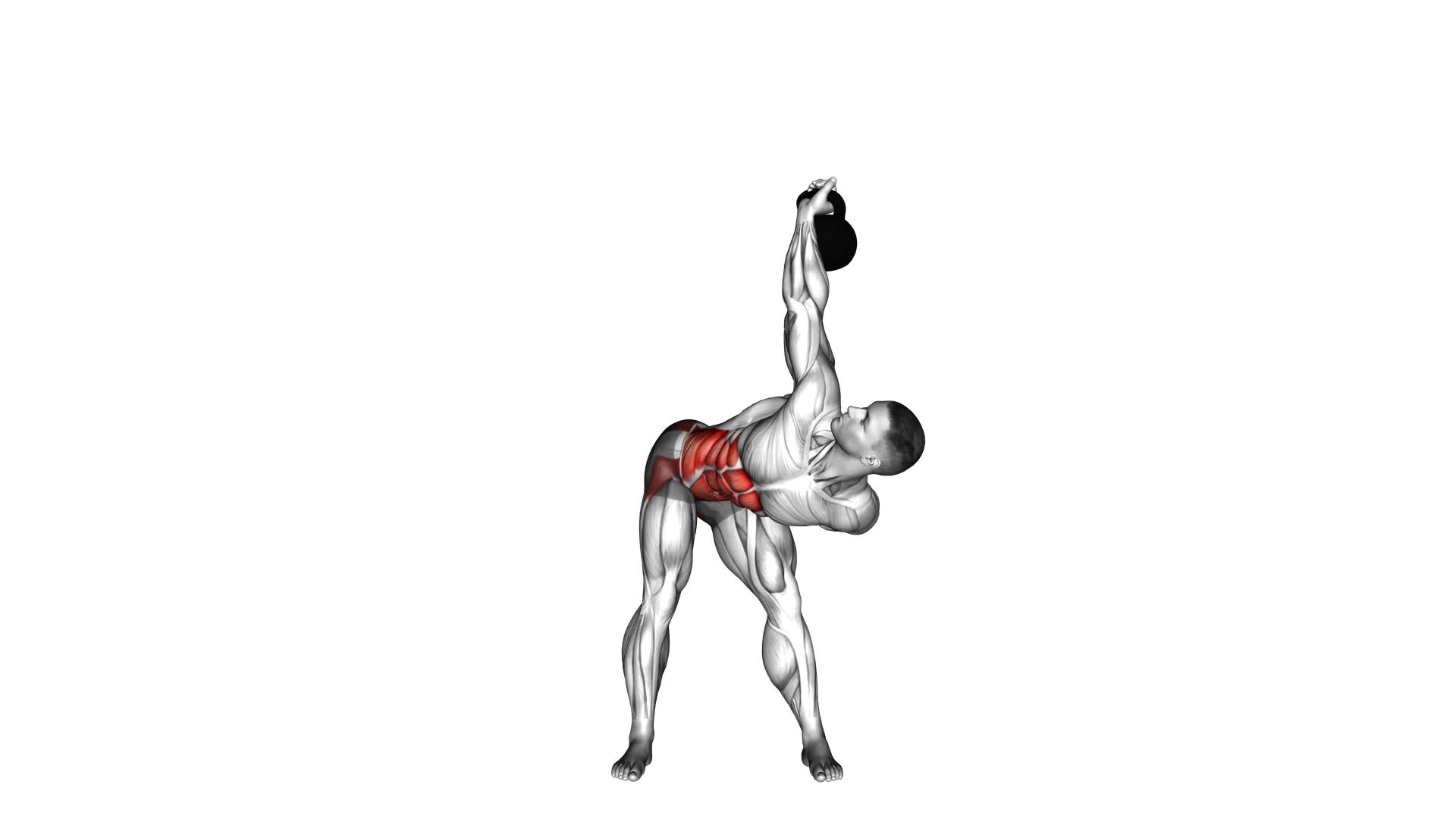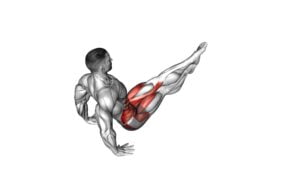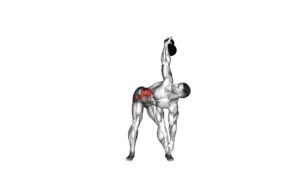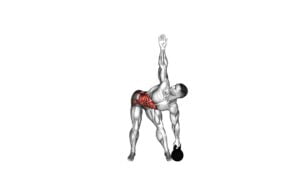Kettlebell Advanced Windmill – Video Exercise Guide & Tips

Are you looking to take your kettlebell workouts to the next level?
Watch This Exercise Video
In this video exercise guide, you'll learn all about the Kettlebell Advanced Windmill.
Discover the benefits of this challenging exercise, master the proper technique, and avoid common mistakes.
Plus, we'll provide tips on how to increase the difficulty and offer modifications for beginners or those with limited mobility.
Get ready to incorporate the Kettlebell Advanced Windmill into your workout routine and see amazing results.
Key Takeaways
- The Kettlebell Advanced Windmill improves core strength and stability.
- It targets muscles in the shoulders, hips, and legs for a full-body workout.
- It enhances flexibility and mobility.
- It helps prevent lower back pain.
Benefits of the Kettlebell Advanced Windmill
The Kettlebell Advanced Windmill is a highly effective exercise that offers numerous benefits. One of the main benefits is its ability to improve core strength and stability. The movement requires you to engage your core muscles to maintain proper form throughout the exercise.
Additionally, the Kettlebell Advanced Windmill targets the muscles in your shoulders, hips, and legs, making it a great full-body workout. By incorporating kettlebell windmill variations into your routine, you can also enhance your flexibility and mobility. The exercise promotes a greater range of motion in your shoulders and hips, leading to improved overall flexibility.
Another advantage of the Kettlebell Advanced Windmill is its ability to improve posture and body alignment. By performing the exercise with proper technique, you can strengthen the muscles that support good posture, helping to prevent common posture-related issues such as lower back pain.
Proper Technique for the Kettlebell Advanced Windmill
To perform the Kettlebell Advanced Windmill with proper technique, you must maintain a strong and stable core throughout the exercise. Proper alignment and core engagement are crucial for executing this movement effectively and safely.
First, start by standing with your feet shoulder-width apart and the kettlebell in one hand, held overhead with a straight arm. Your feet should be pointing slightly outward to allow for better stability. As you begin the movement, shift your weight to one side while keeping your core tight and engaged.
Next, initiate the movement by hinging at the hips, pushing them back and maintaining a straight spine. Your opposite arm should be extended out to the side for balance, as you slowly lower your torso towards the ground. Keep your eyes fixed on the kettlebell throughout the exercise to maintain proper alignment.
As you descend, focus on maintaining a strong and stable core. Avoid twisting or leaning to the side, as this can put unnecessary strain on your lower back. Instead, engage your core muscles to help stabilize your body and maintain proper alignment.
By following these guidelines, you can ensure that you're performing the Kettlebell Advanced Windmill with proper technique, maximizing effectiveness and minimizing the risk of injury.
Now, let's move on to the next section where we'll discuss common mistakes to avoid during the kettlebell advanced windmill.
Common Mistakes to Avoid During the Kettlebell Advanced Windmill
To perform the kettlebell advanced windmill correctly and avoid common mistakes, it's essential to focus on proper form. Keep your core engaged and maintain a straight line from your head to your heels throughout the exercise.
Additionally, be mindful of injury prevention techniques, such as not overextending your spine or shoulders, and avoid rushing through the movement to ensure proper execution.
Proper Form Essentials
You should focus on maintaining proper form to avoid common mistakes during the Kettlebell Advanced Windmill. Proper form is crucial for injury prevention and ensuring that you get the most out of this exercise.
One common mistake to avoid is bending your knees too much, as this takes away from the focus on your core and decreases the effectiveness of the exercise.
Another mistake isn't keeping your arm extended overhead throughout the movement. This can lead to strain on your shoulder and decrease stability.
Additionally, make sure to engage your core and keep your back straight throughout the exercise.
By focusing on these proper form essentials, you can perform the Kettlebell Advanced Windmill safely and effectively.
Now let's discuss some injury prevention techniques to further enhance your workout.
Injury Prevention Techniques
One important technique for preventing injuries during the Kettlebell Advanced Windmill is to avoid bending your knees too much. Keeping your knees slightly bent will provide stability and reduce the risk of strain on your joints.
Another injury prevention technique is to start with a lighter kettlebell and gradually increase the weight as you gain strength and improve your form. This will help you avoid overexertion and potential muscle strains.
Additionally, it's important to maintain proper alignment throughout the exercise and avoid twisting or rotating your torso too forcefully.
Beginners can modify the exercise by using a lower weight kettlebell or performing the movement without any weight until they feel comfortable and confident.
By following these injury prevention techniques and modifications for beginners, you can minimize the risk of injuries during the Kettlebell Advanced Windmill.
Now let's move on to discussing the common execution errors to watch out for.
Common Execution Errors
A common mistake to avoid during the Kettlebell Advanced Windmill is failing to maintain a neutral spine throughout the exercise. This error can lead to strain and potential injury on the lower back. To prevent this, make sure to engage your core muscles and keep your spine straight throughout the movement.
Another common execution error is using too heavy of a kettlebell. This can compromise your form and increase the risk of injury. Start with a lighter weight and gradually increase as you build strength and confidence.
It's also important to avoid rushing through the exercise. Take your time to perform each movement with control and precision.
Tips for Increasing the Difficulty of the Kettlebell Advanced Windmill
To increase the difficulty of the Kettlebell Advanced Windmill, try incorporating heavier weights into your routine. This will challenge your muscles even more and help you build strength and stability. Here are some advanced modifications you can try to take your Windmill to the next level:
- Increase the weight: Gradually add more weight to your kettlebell as you become stronger and more comfortable with the exercise. This will intensify the challenge and force your muscles to work harder.
- Slow down the movement: Instead of rushing through the exercise, focus on performing each rep with controlled and deliberate movements. This will increase the time under tension and enhance the difficulty.
- Try a single-arm variation: Once you have mastered the two-arm version, you can progress to a single-arm Windmill. This requires even more core strength and stability.
- Incorporate a bottom-up position: Holding the kettlebell with the bottom facing up adds an extra stability challenge to the exercise. This will engage your muscles in a different way and increase the difficulty of the movement.
Remember to always maintain proper form and listen to your body. It's essential to progress gradually and only increase the difficulty when you feel ready. Keep challenging yourself and enjoy the benefits of the Kettlebell Advanced Windmill.
Modifications for Beginners or Those With Limited Mobility
If you're a beginner or have limited mobility, there are modifications you can make to the Kettlebell Advanced Windmill exercise to accommodate your needs. These modifications allow you to still benefit from the exercise while taking into consideration your current fitness level or any physical limitations you may have.
One modification you can try is to use a lighter kettlebell or even a dumbbell instead. This will reduce the load and make it easier to perform the exercise. You can also start by practicing the movement without any weight at all, focusing on form and technique.
Another modification is to decrease the range of motion. Instead of reaching all the way down to touch your toes, you can stop at a comfortable position that allows you to maintain proper alignment and stability. Gradually increase the range of motion as you become more comfortable and confident with the exercise.
Progressions for beginners or those with limited mobility can include starting with a basic side bend exercise using just your body weight. Once you've mastered the side bend, you can then progress to using a kettlebell or dumbbell to add resistance.
Remember to always listen to your body and work within your own limits. By making these modifications and progressions, you can still reap the benefits of the Kettlebell Advanced Windmill exercise while accommodating your individual needs.
Incorporating the Kettlebell Advanced Windmill Into Your Workout Routine
Now that you understand the benefits of the kettlebell advanced windmill, it's time to incorporate this exercise into your workout routine.
To ensure proper form and technique, focus on maintaining a strong core and stable shoulder throughout the movement.
As you progress, feel free to explore variations of the windmill exercise to challenge yourself at different levels of difficulty.
Benefits of Windmill Exercise
One key benefit of incorporating the kettlebell advanced windmill into your workout routine is its ability to strengthen multiple muscle groups simultaneously. This exercise provides a wide range of benefits that can enhance your overall fitness level.
Here are some of the advantages you can expect:
- Improved core strength: The windmill exercise engages your core muscles, including the abs and obliques, helping to develop a strong and stable midsection.
- Increased flexibility: By performing the windmill, you can improve your flexibility and range of motion, particularly in the hips, shoulders, and hamstrings.
- Enhanced balance and stability: The exercise requires you to maintain proper balance and stability throughout the movement, which can help improve your overall coordination.
- Injury prevention: The windmill exercise strengthens the muscles responsible for stabilizing your joints, reducing the risk of injury during other activities.
With these benefits in mind, it's important to focus on proper form and technique to maximize your results and minimize the risk of injury.
Proper Form and Technique
To ensure maximum results and minimize the risk of injury, incorporate the kettlebell advanced windmill into your workout routine by focusing on proper form and technique.
The advanced windmill variations offer a challenging full-body exercise that targets the core, shoulders, and hips.
Start by holding the kettlebell in one hand, with your feet slightly wider than shoulder-width apart. Lift the kettlebell overhead, keeping your arm straight.
Slowly bend sideways at the hips while keeping your back straight and chest lifted. Lower the kettlebell towards the opposite foot, maintaining a strong core and stable hips.
Engage your glutes and hamstrings to return to the starting position. It's crucial to maintain proper alignment and control throughout the movement to prevent injury.
Remember to start with a lighter weight and gradually increase as your form improves.
Variations for Different Levels
Incorporate the kettlebell advanced windmill into your workout routine by exploring variations suitable for different levels. Here are some variations that cater to beginners and advanced practitioners:
- Beginner Variation: Start with a lighter kettlebell and focus on mastering the basic form of the windmill. Gradually increase the weight as you gain strength and stability.
- Single Arm Variation: Once you feel comfortable with the basic windmill, try performing it with just one arm. This will increase the demand on your core and shoulder stability.
- Bottoms-Up Variation: For a greater challenge, try performing the windmill with a kettlebell held in the bottoms-up position. This will require even more grip strength and shoulder stability.
- Dynamic Variation: To take your windmill to the next level, incorporate dynamic movements such as adding a kettlebell swing or clean into the exercise. This will engage more muscles and increase the intensity of the workout.
Frequently Asked Questions
What Are the Potential Risks or Injuries Associated With Performing the Kettlebell Advanced Windmill Incorrectly?
When performing the kettlebell advanced windmill incorrectly, there are potential risks and injuries involved. These include strains or sprains in your shoulders, back, or hips, as well as muscle imbalances and joint stress.
Incorrect form can also lead to lower back pain or even herniated discs. It's important to maintain proper alignment and technique throughout the exercise to avoid these potential dangers.
Can the Kettlebell Advanced Windmill Help Improve Flexibility and Mobility?
Improving flexibility and increasing mobility are two benefits that the Kettlebell Advanced Windmill can provide. By incorporating this exercise into your routine, you can enhance your range of motion and loosen tight muscles.
The Kettlebell Advanced Windmill targets the core, hips, and shoulders, promoting flexibility in those areas. As you perform the exercise, you'll also develop better shoulder stability and overall body control.
Make sure to follow proper form and technique to maximize the benefits and minimize the risk of injury.
How Often Should the Kettlebell Advanced Windmill Be Performed for Optimal Results?
To get optimal results from the kettlebell advanced windmill, it's important to perform it with the right frequency. Consistency is key here. By incorporating the kettlebell advanced windmill into your routine at least 2-3 times a week, you can improve your strength, flexibility, and mobility.
However, it's crucial to focus on proper form to avoid injuries. So, make sure you follow the exercise guide and tips provided to perform the kettlebell advanced windmill correctly.
Are There Any Specific Warm-Up Exercises or Stretches Recommended Before Attempting the Kettlebell Advanced Windmill?
Before attempting the kettlebell advanced windmill, it's important to warm up your body and stretch to prevent injury. Engaging in warm-up exercises like jogging or jumping jacks can increase blood flow and prepare your muscles for the workout ahead.
Additionally, incorporating stretches that target the shoulders, hips, and hamstrings can improve flexibility and range of motion. Don't skip these crucial steps to ensure a safe and effective kettlebell advanced windmill session.
Can the Kettlebell Advanced Windmill Be Incorporated Into a Cardio-Focused Workout Routine?
Yes, the kettlebell advanced windmill can definitely be incorporated into a cardio-focused workout routine.
This exercise combines strength training with cardiovascular conditioning, making it a great addition to your cardio kettlebell exercises.
The kettlebell windmill helps to improve core stability and flexibility while also increasing heart rate and calorie burn.
Conclusion
The Kettlebell Advanced Windmill is a powerful exercise that offers a range of benefits, including improved core strength, flexibility, and shoulder stability.
By following the proper technique and avoiding common mistakes, you can maximize the effectiveness of this exercise. For those looking for a challenge, there are tips provided to increase the difficulty level.
Additionally, modifications are available for beginners or individuals with limited mobility.
Incorporating the Kettlebell Advanced Windmill into your workout routine can help enhance overall fitness and performance.

Author
Years ago, the spark of my life’s passion ignited in my mind the moment I stepped into the local gym for the first time. The inaugural bead of perspiration, the initial endeavor, the very first surge of endorphins, and a sense of pride that washed over me post-workout marked the beginning of my deep-seated interest in strength sports, fitness, and sports nutrition. This very curiosity blossomed rapidly into a profound fascination, propelling me to earn a Master’s degree in Physical Education from the Academy of Physical Education in Krakow, followed by a Sports Manager diploma from the Jagiellonian University. My journey of growth led me to gain more specialized qualifications, such as being a certified personal trainer with a focus on sports dietetics, a lifeguard, and an instructor for wellness and corrective gymnastics. Theoretical knowledge paired seamlessly with practical experience, reinforcing my belief that the transformation of individuals under my guidance was also a reflection of my personal growth. This belief holds true even today. Each day, I strive to push the boundaries and explore new realms. These realms gently elevate me to greater heights. The unique combination of passion for my field and the continuous quest for growth fuels my drive to break new ground.







